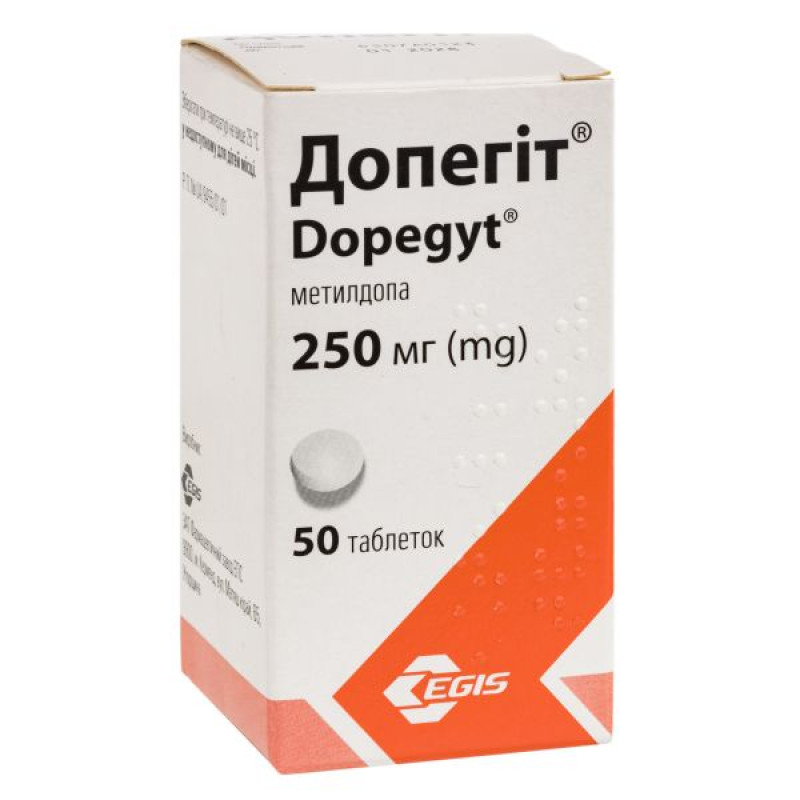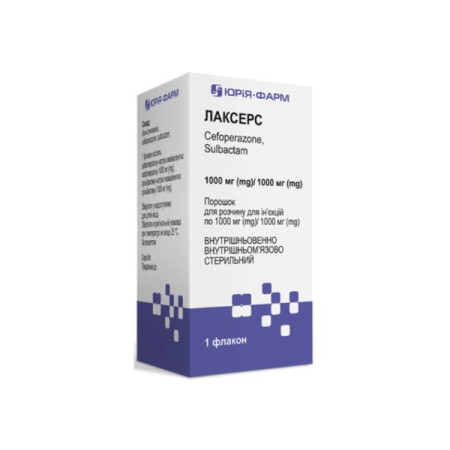Dopegit tablets 250 mg No. 50

Instructions for Dopegit tablets 250 mg No. 50
Composition
active ingredient: methyldopa;
1 tablet contains 250 mg of methyldopa (in the form of sesquihydrate 282 mg);
excipients: magnesium stearate, stearic acid, sodium starch glycolate (type A), ethylcellulose, corn starch, talc.
Dosage form
Pills.
Main physicochemical properties: white or grayish-white, round, flat tablets with a bevel, smooth on one side, engraved with “DOPEGYT” on the other side, odorless or almost odorless.
Pharmacotherapeutic group
Antiadrenergic agents with a central mechanism of action.
ATX code C02A B01.
Pharmacological properties
Pharmacodynamics
Dopegit® (methyldopa) is a hypotensive drug with a central mechanism of action. Its mechanism of action is not fully understood. Once in the central nervous system, the drug exerts a hypotensive effect due to its active metabolites (alpha-methyl-epinephrine and alpha-methyl-norepinephrine). By stimulating alpha2-adrenoceptors of brainstem neurons, it reduces the tone of the sympathetic nervous system.
Moderately reduces the level of renin in blood plasma and total peripheral vascular resistance.
By inhibiting the enzyme dopa decarboxylase, it reduces the synthesis of noradrenaline, dopamine, serotonin and the tissue concentration of noradrenaline and adrenaline.
Methyldopa has no direct effect on cardiac function. Cardiac output changes little. Does not cause reflex tachycardia, increases glomerular filtration rate and renal blood flow, as well as filtration fraction. Slightly reduces heart rate. Effectively reduces supine and standing blood pressure, rarely causes orthostatic hypotension.
Pharmacokinetics
After internal use, approximately 50% of the drug is absorbed in the gastrointestinal tract. Binding to blood plasma proteins is insignificant - up to 20%. The maximum decrease in blood pressure occurs 4–6 hours after oral administration of the drug and is maintained for 12–24 hours. After repeated administration of the drug, the maximum decrease in blood pressure is noted within 2–3 days. After discontinuation of the drug, blood pressure returns to its previous level within 1–2 days.
Methyldopa is extensively metabolized, primarily in the liver. Its active metabolite, alpha-methylnorepinephrine, is derived from central adrenergic neurons.
In addition, many other metabolites are known to be excreted in the urine.
Approximately 70% of methyldopa is excreted in the urine as methyldopa or its sulfonate conjugates. The remainder is excreted in the feces as methyldopa. In normal renal function, the half-life is 1.7 hours. Complete elimination of the drug occurs after 36 hours.
Methyldopa is removed from the body by dialysis. 60% of absorbed methyldopa can be removed from the circulation with 6 hours of hemodialysis, and 22–39% with peritoneal dialysis.
Methyldopa crosses the placental barrier and enters breast milk.
Special group of patients
In renal failure, methyldopa excretion is slowed down according to the degree of kidney damage. In severe kidney damage (without dialysis), the half-life of methyldopa is 10 times shorter than under normal conditions.
Indication
Arterial hypertension.
Contraindication
Hypersensitivity reactions to the components of the drug; liver dysfunction associated with previous methyldopa therapy; acute liver dysfunction (including acute hepatitis and active cirrhosis); concomitant use with monoamine oxidase inhibitors (MAOIs); depression; pheochromocytoma; porphyria.
Interaction with other medicinal products and other types of interactions
Dopegit® should be taken with extreme caution in combination with any of the following drugs:
Sympathomimetics (possible increase in vasopressor effect); tricyclic antidepressants; phenothiazines; oral iron preparations (bioavailability of methyldopa may decrease); nonsteroidal anti-inflammatory drugs; estrogens.
The antihypertensive effect of methyldopa is enhanced when used with other antihypertensive drugs and anesthetics.
Idiosyncrasy may occur when used concomitantly with antihypertensive drugs.
Methyldopa and the following drugs may alter each other's effects:
lithium (possible increase in lithium toxicity); levodopa [reduction of antiparkinsonian effect, increased adverse effects on the central nervous system (CNS)]; alcohol and drugs that depress the central nervous system (increased – depressant effect on the central nervous system); anticoagulants (increased anticoagulant effect, risk of bleeding); bromocriptine (may adversely affect prolactin concentration).
Application features
There are isolated cases of hemolytic anemia during treatment with methyldopa. If symptoms of anemia appear, it is necessary to determine the level of hemoglobin and hematocrit. If anemia is confirmed, additional studies should be performed to determine the degree of hemolysis. If hemolytic anemia is detected, Dopegyt should be discontinued.
The hemolytic anemia resolved after drug withdrawal. In some cases, steroid treatment was necessary. Discontinuation of methyldopa (with or without corticosteroid) usually resulted in rapid remission. However, there have been isolated fatalities. Other causes of hemolytic anemia should also be considered. If the hemolytic anemia was due to methyldopa, the drug should be discontinued. A positive Coombs test becomes negative within weeks to months after methyldopa treatment is discontinued.
A positive Coombs test is not a contraindication to methyldopa therapy. If a positive Coombs test is detected during methyldopa therapy, the physician should rule out hemolytic anemia or determine whether a positive Coombs test has any clinical significance. This may be a problem if the patient requires a blood transfusion. In this case, both a direct and an indirect Coombs test should be performed. In the absence of hemolytic anemia, only the direct Coombs test will be positive. If the indirect Coombs test is also positive, problems may arise. In this case, the assistance of a transfusion specialist or a hematologist is necessary.
Liver function tests should be performed during the first 6–12 weeks of treatment or in the event of unexplained fever. If changes in liver enzymes or jaundice occur, a hypersensitivity reaction should be suspected, which may lead to cholestasis, hepatocellular damage or hepatitis. Very rarely, fatal hepatic necrosis may occur. Therefore, when changes in liver enzymes or liver failure occur, methyldopa treatment should be discontinued immediately. These patients should never be given methyldopa again. If body temperature and liver function tests that were impaired by methyldopa return to normal after discontinuation of the drug, methyldopa should not be given to these patients again.
Patients with liver disease or a history of liver dysfunction require special caution when treated with methyldopa.
Granulocytopenia and thrombocytopenia may occur very rarely. They usually resolve upon discontinuation of methyldopa treatment.
Some patients may develop edema or weight gain during methyldopa treatment, which may be treated with the addition of a diuretic. Methyldopa treatment should not be continued if edema increases or symptoms of heart failure develop.
Methyldopa is removed by dialysis. Therefore, hypertension may recur after this procedure (see also section "Method of administration and dosage").
Because methyldopa fluoresces at the same wavelength as catecholamines, high levels of catecholamines may be detected in the urine, indicating the development of pheochromocytoma. It is important to recognize this phenomenon before a patient with a possible pheochromocytoma undergoes surgery. Methyldopa treatment of patients with catecholamine-secreting tumors, such as pheochromocytoma or paraganglioma, is contraindicated.
However, methyldopa does not affect the measurement of vanillylmandelic acid (VMA).
Patients treated with methyldopa should be given lower doses of anaesthetics. If hypotension develops during anaesthesia, it can be controlled with vasoconstrictors. Adrenergic receptors remain sensitive during methyldopa treatment (see also section 4.5).
In patients with severe bilateral cerebrovascular disease, involuntary abnormal body movements may rarely occur. Therefore, when abnormal movements occur, methyldopa treatment should be discontinued immediately.
Methyldopa should be used with extreme caution in patients whose close relatives suffer from hepatic porphyria.
During treatment with methyldopa, it is necessary to avoid drinking alcoholic beverages.
Reversible leukopenia and fever may occur during treatment with methyldopa.
Changes in laboratory tests, such as darkening of urine due to the breakdown of methyldopa or its metabolites, have also been observed.
Methyldopa may interfere with the determination of urinary uric acid concentration by the phosphotungstate method, serum creatinine by the alkaline picrate method, and aspartate aminotransferase (AST (SGOT)) by the colorimetric method.
The effect of methyldopa on the determination of AST (SGOT) in spectrophotometric methods has not been reported.
Ability to influence reaction speed when driving vehicles or other mechanisms
During treatment with the drug, you should refrain from driving vehicles and potentially dangerous activities that require concentration.
Use during pregnancy or breastfeeding
During treatment with the drug in pregnant or breastfeeding women, no harmful effects on the fetus or newborn were detected.
Published reports of methyldopa treatment in all trimesters of pregnancy indicate the possibility of long-term harmful effects of the drug on the fetus.
Methyldopa crosses the placental barrier, into breast milk and umbilical cord blood.
Although no information has been received about teratogenic effects on the fetus, the risk of exposure cannot be excluded. The drug can be prescribed to pregnant women or women planning pregnancy, as well as to women who are breastfeeding, if the expected benefit outweighs the potential risk.
Method of administration and doses
Methyldopa treatment requires individual dosage adjustment. Tablets should be taken orally before or after meals.
Adults
The usual starting dose of methyldopa for adults is 250 mg once daily (at bedtime) for the first 2 days. The daily dose can then be gradually increased by 250 mg every 2 days until adequate blood pressure control is achieved. Since a sedative effect may occur for 2–3 days after initiation of therapy and with subsequent dose increases, it is recommended that the increased dose be taken once in the evening.
The maintenance dose of the drug is usually 500 mg - 2 g per day, which should be divided into
2–4 doses. The maximum daily dose should not exceed 3 g. If, while taking the drug at a dose of 2 g per day, there is insufficiently effective reduction in blood pressure (BP), it is recommended to combine Dopegit® with other antihypertensive agents. Tolerance to the drug may develop, usually between the second and third months of therapy. The appointment of an additional diuretic or an increase in the dose of methyldopa will restore effective blood pressure control.
Withdrawal of methyldopa is accompanied by a reversible increase in blood pressure, which is usually observed within 48 hours.
Dopegit® can be prescribed to patients who are already receiving therapy with other antihypertensive drugs, provided that these drugs are gradually withdrawn. In such cases, the initial dose of Dopegit® should not exceed 500 mg per day. The dose should be increased if necessary, with an interval of at least 2 days.
When using Dopegit® as an addition to previously prescribed antihypertensive therapy, it may be necessary to adjust the doses of antihypertensive drugs to ensure a smooth transition.
Elderly patients
For patients of this age group, the initial dose should be as low as possible and not exceed a daily dose of 250 mg, since a sedative effect is very common. If necessary, the dose can be increased. The duration of the intervals between dose increases is at least 2 days. The maximum daily dose of Dopegit® should not exceed 2 g per day.
Children weighing more than 25 kg
Children should use tablets with a dosage that corresponds to the prescribed dose.
For children, the initial dose of the drug is 10 mg/kg of body weight per day. The daily dose is divided into 2–4 doses. If necessary, the dose of the drug can be gradually increased until the desired effect is achieved. An interval of at least 2 days must be observed between increasing the dose of the drug.
The maximum daily dose of Dopegit® is 65 mg/kg body weight per day, but not more than 3 g per day.
Patients with impaired renal function require lower doses of the drug. In case of mild renal dysfunction (glomerular filtration rate - 60-89 ml/min/1.73 m2), the interval between doses of the drug is recommended to be increased to 8 hours, in case of moderate (glomerular filtration rate - 30-59 ml/min/1.73 m2) - to 8-12 hours, in case of severe renal dysfunction (glomerular filtration rate - < 30 ml/min/1.73 m2) - to 12-24 hours.
Methyldopa is removed by dialysis; after hemodialysis, the patient should be given an additional 250 mg of the drug to prevent an increase in blood pressure.
Children
The drug should be prescribed to children with a body weight of at least 25 kg, taking into account the content of the active substance in this dosage form.
Overdose
Symptoms: severe arterial hypotension, severe drowsiness, weakness, bradycardia, dizziness, constipation, bloating, flatulence, diarrhea, nausea, vomiting.
Treatment: immediately after overdose - gastric lavage; induction of vomiting may reduce the amount of drug absorbed. If the drug has already been absorbed, intravenous fluid infusion may promote its excretion in the urine. Close monitoring of heart rate, blood volume, electrolyte balance, intestinal function, renal and cerebral function is necessary. Treatment is symptomatic.
Adverse reactions
Hypersensitivity reactions are possible in individuals with individual intolerance to any of the components of the drug.
Central nervous system: sedation (usually transient), headache, paresthesia, dizziness, anxiety, depression, psychosis (moderate and transient), nightmares, decreased libido, impotence; parkinsonism, choreoathetosis, cerebrovascular insufficiency (may be accompanied by hypotension), peripheral facial paralysis (Bell's palsy); decreased mental activity, carotid sinus syndrome, mental disorders.
Cardiovascular system: exacerbation of angina pectoris, congestive heart failure, sinus bradycardia, carotid sinus hypersensitivity, orthostatic hypotension (reduction of the dose of the drug is recommended), peripheral edema, weight gain, myocarditis, pericarditis, atrioventricular block.
Gastrointestinal: pancreatitis, colitis, vomiting, diarrhea, sialadenitis, inflammation or blackening of the tongue, nausea, vomiting, constipation, bloating, flatulence, dry mouth, glossodynia.
Hepatic: jaundice, hepatitis, cholestasis, changes in liver function tests, necrotizing hepatitis.
Blood and lymphatic system disorders: bone marrow depression, leukopenia, granulocytopenia, thrombocytopenia, hemolytic anemia, eosinophilia, positive test for antinuclear antibodies, lupus erythematosus cells, rheumatoid factor, positive Coombs test.
Immune system disorders: vasculitis, drug-induced fever, eosinophilia.
From the endocrine system: hyperprolactinemia, gynecomastia, galactorrhea, amenorrhea, breast enlargement.
Skin and subcutaneous tissue disorders: redness; toxic epidermal necrolysis, eczema or lichen-like rash, angioedema, urticaria.
Musculoskeletal system: arthralgia, joint swelling, muscle pain, myalgia.
Respiratory system: nasal congestion.
Laboratory indicators: positive tests for antinuclear antibodies, LE cells and rheumatoid factor, increased activity of hepatic transaminases, increased concentration of urea in the blood.
Others: impotence, ejaculation disorders, sialadenitis, breast enlargement, gynecomastia, amenorrhea, lactation disorder, mental disorders including nightmares, reversible mild psychosis or depression, decreased libido.
Elderly patients are more likely to experience fainting. This may be due to increased susceptibility to the drug and severe atherosclerotic vascular disease. The development of fainting can be prevented by reducing the dose of Dopegit®.
Expiration date
5 years.
Storage conditions
Store at a temperature not exceeding 25 °C in a place inaccessible to children.
Packaging
50 tablets in a glass bottle; 1 bottle in a cardboard box.
Vacation category
According to the recipe.
Producer
CJSC Pharmaceutical Plant EGIS, Hungary.
Location of the manufacturer and its business address
9900, Kermend, 65 Matyash Kirai St., Hungary.
There are no reviews for this product.
There are no reviews for this product, be the first to leave your review.
No questions about this product, be the first and ask your question.













